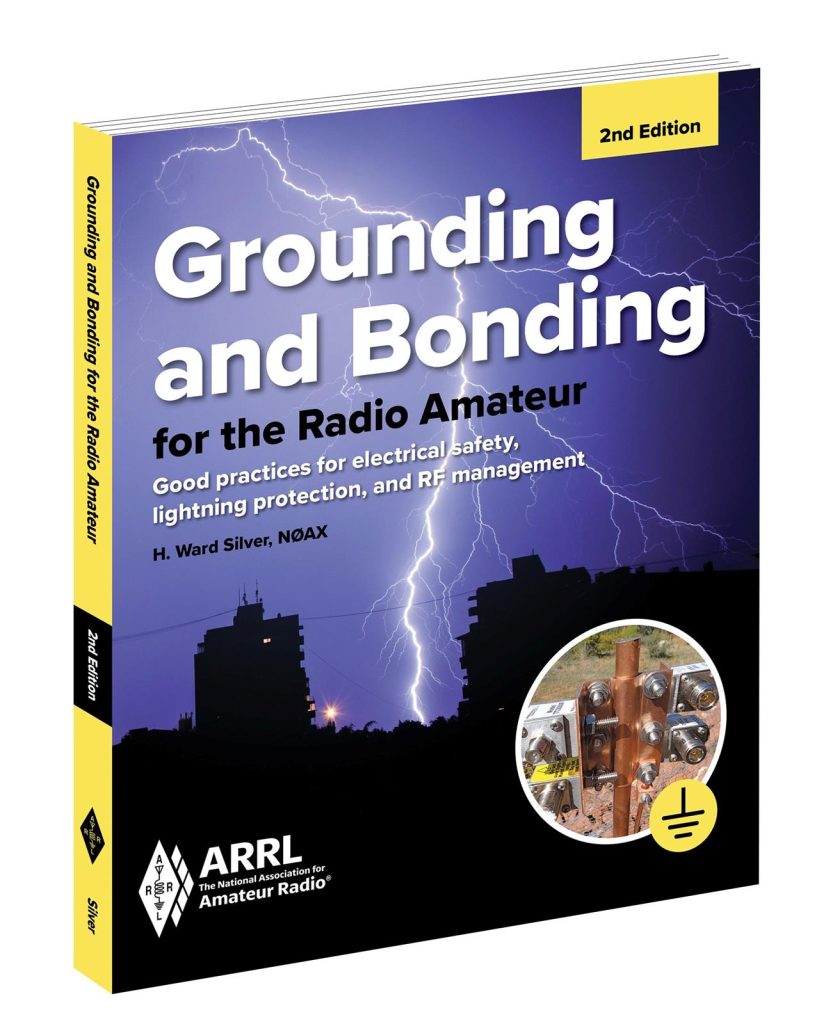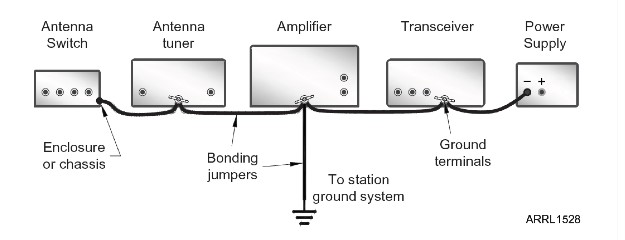Operating from a temporary setup—in a park, on a summit, from a rare grid or county, or for a special event—has become very popular. This is a great thing for ham radio! Being able to operate effectively from “the field” is key to fulfilling the emergency communications mandate in our Basis and Purpose. I expect to see more and more portable operation as programs like Parks On The Air (POTA) grow.
Creating a temporary station involves managing power and getting all of the equipment connected together. There are two basic needs to get right: generator power safety and RF management. (Batteries have their own challenges not addressed here.) My advice here follows the more detailed guidelines in the ARRL book, Grounding and Bonding for the Radio Amateur.

Generator Power Safety
While battery power is becoming more convenient and capable, the gas-powered ac generator is still very common for portable operation. Highly engineered, they offer relatively trouble-free operation. Even though they incorporate safety features at multiple levels, there are still basic safety concerns you should be aware of and respect. Avoiding shock hazards should be a top priority for individuals or clubs.
Generators that can be moved from one place to another by a person are considered “portable” by the NEC (National Electrical Code). A “mobile” generator is capable of being moved on wheels or rollers and includes generators mounted in a vehicle. (These are multi-kW units much larger than commonly used by hams.) Two portable generators are shown below. Even though the second generator has wheels, it is designed to be moved by one person and is considered portable.


The first model is a 1,600-watt inverter generator (the A-iPower SUA2000I) that weighs 46 pounds and can be carried by one person. Next is a 4,000-watt generator, the AP4000 from the same company. Both deliver 120 VAC and have circuit-breaker protection on all of their outputs. Both have ground terminals—is a ground rod required?
According to the NEC (see article 250.34), a ground rod or other similar Earth electrode is not required for portable generators as long as:
- The generator has receptacles mounted on the generator panel, and receptacles have equipment grounding terminals (the ground pin of an ac receptacle) that are bonded to the frame of the generator.
This means the frame of the generator, whether you can touch the frame (like the wheeled generator) or not (like the insulated inverter generator), serves as the grounding (meaning voltage reference) point for any connected equipment. Equipment must be connected to the generator through a three-wire power cord. Any exposed metal of that equipment must be connected to the ground wire of the power cord. That connects the enclosures of properly constructed equipment to the frame of the generator. No special connections are required and the system’s “ground” doesn’t have to be “the Earth.”
So, you don’t have to have a ground rod either at the generator or at the powered equipment (i.e., your portable station). What if you decide to use one anyway? A single ground rod at the generator or the station is okay and doesn’t create any hazards. It’s also common to put one ground rod at the generator and one at the station. In that case, it is an NEC requirement (not optional!) that all ground rods be bonded together. This protects you against hazardous voltages created by current flowing through dirt instead of a copper ground conductor.
That bonding requirement means it’s really important your power cord be in good shape and the plugs and receptacles are not worn or loose. If there is any question, get a new cord, replace plugs or receptacles, do whatever is needed to ensure all connections are in good shape.
- A tip from a veteran of numerous Field Days and portable setups is to secure the power cord at each end. Tie the cord to a tent stake, the generator frame, or even a ground rod so that if someone trips over the cord, for example, the powered equipment isn’t dragged off the operating position. If you have a very long cord, consider securing the cord along its length, as well. The same goes for long coaxial cables to antennas. If people are moving around near cables, expect they will snag one sooner or later—take appropriate protective steps.
Water is another enemy of ac power safety in portable stations, usually in the form of rain. Most modern generators are at least partially protected against rain “getting into” their circuitry. Many have GFCI-protected outlets, as well. But don’t assume that’s enough—cover or protect your generator against rain. Puddles and standing water can make a substantial splash, too.
At your station, protect your ac power strips and any outlets. Consider using a GFCI-protected outlet like the Morris 89008 shown below. A wide range of products are available. You can even make your own “GFCI-In-A-Box” in a waterproof outlet as shown in yellow.


RF Management
Another common problem in portable stations is RF interference from transmitted signals. At home in a fixed station, you can build in protection against RFI in many ways. In a portable station, however, you are definitely more exposed and problems can crop up. What to do?
First, recognize that you are pretty close to your nearby antennas. There are many pictures of operators sitting at a picnic table with a vertical or loop nearby. Others have a wire antenna like an End-Fed Half-Wave (EFHW) overhead. Operating on the HF bands, you are probably less than one wavelength from the antenna and will experience strong RF fields at your station. (See the ARRL’s web site on RF exposure to learn about minimum safe distances for various power levels and frequencies. You’ll need to plan for setting up a station in that environment.
You might get lucky—throw your equipment on a table, hook up the cables, and have no RFI whatsoever. HF transceivers are pretty good at keeping RF from getting where it shouldn’t be, but there are some weak spots in their armor. Computers and accessories can be very susceptible to unwanted RF, too.
To manage that RF, bonding is your best friend. Bonding only means connecting equipment together to keep it at the same voltage. What the voltage is with respect to the Earth doesn’t really matter, it’s the voltage differences that count. A voltage difference causes current to flow. It’s that RF current getting where it shouldn’t be that causes RFI. If you can reduce the voltage differences through bonding, you can reduce the current, too.
Bonding sounds expensive, but it’s not. If you have some heavy wire (#14 from scraps of ac power cable will do nicely) or flat-weave metallic braid, you have most of what you need. Each piece of radio equipment with an exposed metal enclosure will have some way of connecting the bonding conductor to it. Even antenna switches will have a mounting hole you can use. If you can’t find a hole, use alligator clips on the jumpers—remember, this is temporary!
Connecting the equipment together can be done directly with bonding jumpers as shown below. (Graphic provided courtesy of the ARRL.) Keep the jumpers short and straight. If you are using a ground rod, pick one point, such as the amplifier or the transceiver, to connect to it. If you are not using a ground rod, just ensure that the equipment enclosures are connected to the ac safety ground, usually via an ac supply power cord.

Laptop computers aren’t generally designed to be bonded to anything. (The motherboard ground is often connected to threaded video connector screws.) For a desktop-style PC, you can generally find a connection on a metal rear panel or where the power supply screws attach. Computer mice, keyboard, and USB cables can pick up a lot of RF so be sure to take several ferrite toroids or clamp-on cores (type #31 for HF) in your kit. Use the shortest cables you can and wind the rest on the ferrite core.
Pay special attention to the audio cables going to and from the computer sound card if you are going to be using any of the digital modes like FT8. It doesn’t take much RF getting into the low-level audio to create problems. Be sure the cables are properly shielded and, if necessary, bond the computer and transceiver together. Ferrite cores are useful here, too.
- Another veteran tip is to create an RF “reference plane” by using a metal table or surface for the operating position. Then attach the equipment enclosure to the metal with short wire jumpers and alligator clips. If you don’t have a metal table, just place a sheet of aluminum foil on the table before setting the equipment on it. Clip the equipment to the foil with jumpers and clips. When you’re done, roll up or recycle the foil! Whichever method you use, be sure the reference plane is connected to the ac power source ground, as well.
“Hot spots” can be a problem in temporary stations, even with bonding. They occur where your station equipment layout creates a high-impedance point, excited by the strong RF field. It always seems to be at the end of a microphone or a CW key—OUCH! Cut a quarter-wavelength wire (234/f is close enough in feet) for each band on which a hot spot occurs. Insulate one end and attach the other to an alligator clip and attach the wire at the point of the hot spot. Keep the open end of the wire where it can’t be touched or stepped on. Even QRP operation is sufficient to create enough voltage at the open end for a tingle, and the voltage from 100-watt operation can actually set grass or leaves on fire! So be careful where you run the detuning wire.
What About Lightning?
It is not reasonable to expect a temporary installation to provide lightning protection. Disconnect or lower antennas if there is any chance of lightning occurring in the vicinity. If antenna cables are disconnected, place their ends well away from people and equipment. A lightning detector, such those available from Weather Shack or other vendors, is a good idea. Lightning monitoring apps such as www.blitzortung.org are available for smartphones, tablets, and PCs. If lightning is in your area—which can be a radius of up to 10 miles—get off the air and protect yourself.
And who doesn’t yearn for that perfect hilltop site with clear propagation in all directions? Summits On The Air (SOTA) veteran Steve Galchutt, WGØAT, and his pack goats have operated from many a high place. I asked him about lightning safety when operating on the trail. “If dark clouds are in the area I pack up and without delay head for cover. While SOTAteering, once I hear that familiar snap-crackle-pop in my receiver, I hurry up and finish the pileup (sometimes QRTing immediately!) and begin to hasten my tear down to get ready to head down to lower elevations. Mother Nature Rules! She will beat you! Pay her respect and you will keep breathing!”

